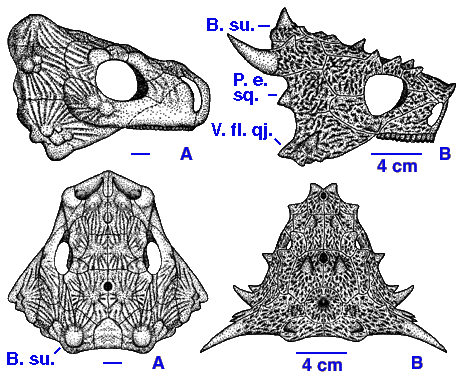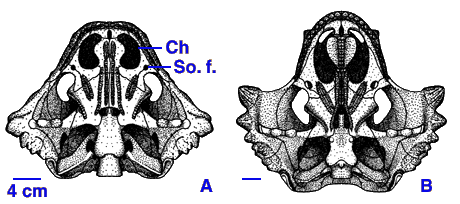Pareiasaur skulls were covered with characteristic sculpturing pattern consisting of bumps, pits, and processes. The numerous specializations of pareiasaur skulls make them easy to recognize. These include (pictured below for easy reference):
- A ventral flange of the quadratojugal.
- A posterior extension of the squamosal that covers the area occupied by the quadrate emargination in other anapsids.
- A large boss on the supratemporal.
- A large ventral process on the angular (a bone in the lower jaw).

Pareiasaur skulls in lateral (A, B) and dorsal (C, D) views. A, C, Bradysaurus baini. B, D, Elginia mirabilis. Abbreviations: B. su., boss of the supratemporal; P. e. sq., posterior extension of the squamosal; V. fl. qj., ventral flange of the quadratojugal. Reproduced with permission from Lee (in press).
It has been suggested that pareiasaurs are the closest known relatives of turtles. This theory is based on several synapomorphies, including the following:
- A choana (internal naris) located far medially and bordered posterolaterally by the palatine.
- A suborbital foramen (a hole in the palate) located far medially and without a contact with the jugal or the maxilla (bones in the side of the cheek and snout, respectively).
- Twenty or fewer presacral vertebrae. Pareiasaurs and turtles generally have a shorter body than other anapsids.
- An acromion process on the scapula. This process buttresses the shoulder girdle against the plastron in most turtles.
- A manual phalangeal formula reduced to 2-3-3-3-3 or less (there are no more than three phalanges in any of the fingers).

Pareiasaur skulls in palatal (roof of the mouth) view. A, Deltavjatia vjatkensis. B, Scutosaurus karspinski. Abbreviations: Ch, choana; So. f., suborbital foramen. Reproduced with permission from Lee (in press).
Continue exploring the wonderful Anapsida!

References:
Laurin M. and R. R. Reisz. 1995. A reevaluation of early amniote phylogeny. Zoological Journal of the Linnean Society 113: 165-223.
Lee, M. S. Y. 1993. The origin of the turtle body plan: bridging a famous morphological gap. Science 261: 1716-1720.
Lee, M. S. Y. In press. A taxonomic revision of pareiasaurian reptiles: implications for Permian terrestrial paleoecology. Modern Geology: 66 pages, 17 figures.







